A 5 to 9 meters long and 3 to 4 feet wide fabric that is simply wrapped around a female form – you will never guess that this simple cloth as a garment would look alluring and graceful in any way, if you just read or heard about it. The beauty and grace of a Sari has to be worn or at least, seen to be believed.
Embed from Getty Images
Sari needs no introduction to a large part of Asia and beyond. It is wrapped around the body over a petticoat skirt, starting from the waist and then going over the body and pleated in sunray pleats in the front and draped over the shoulder, pleated or casually thrown over. It is typically worn along with a midriff revealing fitted blouse (called Choli or sari blouse).
Though typically a traditional wear in the Indian Subcontinent (India, Pakistan, Sri Lanka, Bangladesh, and Nepal) you will find sari-clad women in many South-East Asian countries like Singapore, Burma, Malaysia, Philippines.
It is a common sight in India to see Saris worn by females in all kinds of situations – brides resplendent in ornate saris, policewomen and army personnel in their formal uniform saris, female laborers balancing many things on their head without a care in thin threadbare saris, tourist guides going everywhere in saris, mothers running around their kids in saris, air hostesses in their gracefully pleated saris, sultry actresses in diaphanous chiffon saris and nuns in their chaste and formally pleated unbleached saris. All worn with varying degrees of Panache.
From Indus Valley civilization to today’s modern world, sari has had a long run without seeing much change, unlike any other garment in the world. Sari is the ultimate symbol of Indian culture and the epitome of Indian traditional wear for women.
There are some things common to most saris – a border (which is usually on the hem part of the sari, running the length of the sari or on the top part too), a pallu (on the part of the sari end placed over the shoulder, usually 3 foot in length), and often seen repeated motifs called buttis placed on the body of the sari. Other than the butis made by weaving, Different types of printing including Bandhani, Parsi gara, Madhubani print, hand Bandhej, block printing designs like Bagru, Batik and Dabu, different types of embroidery work including Kashmiri Aari work, Zardosi work, Zari work, gota patti work, Mukaish, Parsi gara work, kamdani and pearl work are done on sarees to bring them to full glory. Tassels may be added to the end of the pallu as a decoration or as a means of finishing the end.
Different kinds of Sarees
- Different kinds of Sarees
- Arini silk
- Art Silk
- Banarasi Brocade sari
- Butidar Banarasi sari
- Balarampuram Sari
- Bandhani Sari
- Baluchari Sari
- Bapta Sari
- Batik Sari
- Berhampuri silk
- Blockprinted saris
- Bomkai/Sonepuri sari silk & cotton
- Brocade
- Chanderi sari
- Chedi Butta sari
- Chettinad Cotton Sari
- Chiffon Sari
- Chikan work sari
- Chinnalapatti silk cotton saris
- Crepe silk sari
- Dhani Kala sari
- Dharamavaram Silk sari
- Dupion silk sari
- Eri silk Sari
- Ghar charo sari
- Ghicha Silk Sari
- Gadwal sari
- Ikkat Sari
- Jaldari Sari
- Jamdani Sari
- Jute sari
- Kalamkari sari
- Kanjeevaram Pattu Saris (Kachipuram)
- Kanchi cotton saris
- Kantha embroidered sari
- Kasavu sari
- Katan silk
- Khadi silk
- Kornad sari (Koorainadu)
- Kora Silk Sari
- Kosa silk
- Kota Sari
- Lal Par Sari
- Linen Sari
- Madhubani silk sari
- Maheswari sari
- Matka Silk Sari
- Moirang phee sarees
- Mysore Silk
- Mulmul Cotton Sarees /Muslin saris
- Muga silk sari
- Mundum Neriyathum
- Narayani Patt Saris
- Narayanpet saris
- Net Saris
- Pasapalli
- Party wear saris
- Pat silk
- Patola Sari
- Paithan saris (Paithani)
- Pochampilli sari
- Polycotton sari
- Resham worked Sari
- Salem Silk Sari
- Sambalpuri Sari
- Sungudi Sari (Sungudi Seelai)
- Tabby silk Sari
- Tant Sari
- Thirubhuvanam sari
- Tircha Baluchar
- Tangail sari
- Temple saree
- Tanjaore sari
- Tassar silk (Tusser)
- Tissue sari
- Uppada pattu sari
- Venkatagiri Sari
- Zari worked sari
- Zardozi worked sari
Arini silk
This is a lightweight silk made in Tiruvannamalai in Tamilnadu District in India. The highly popular sari fabric is handwoven with pure mulberry silk.
Art Silk
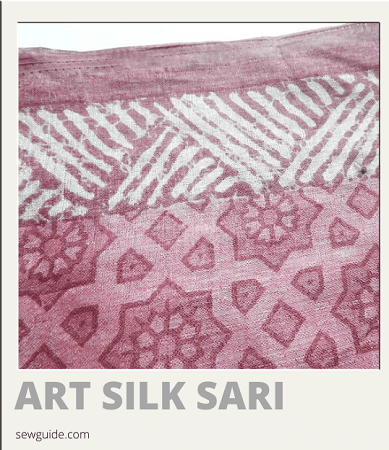
This Sari fabric is made of rayon but has the lustrous look of Silk fabric. When compared to silk sarees, an art sari is very inexpensive. (other names used include banana silk, artificial silk, faux silk)
Banarasi Brocade sari
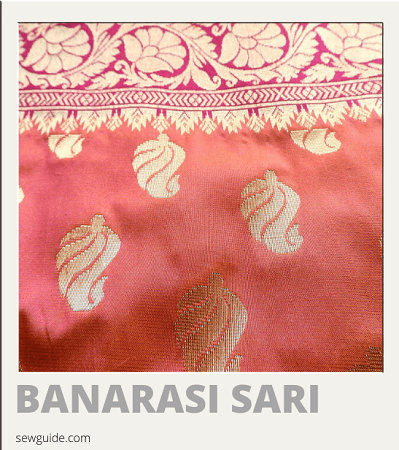
It is a very ornate sari which is made in the State of Utter pradesh, India (Varanasi/Banaras). It has distinctive slightly raised, woven patterns of silk and Zari yarn (brocade work) usually in the Pallu and border. A favourite as a wedding sari.
Butidar Banarasi sari
A Banarasi sari with several repeated motifs names Butis – Resham Butti, Patti Butti, Jhari butti etc are the regularly used motifs.
Balarampuram Sari
Handwoven in the Thiruvananthapuram district of Kerala State in India. It uses Pure Zari thread in the border designs.
Bandhani Sari
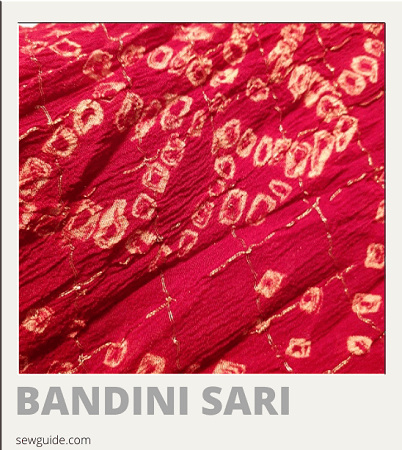
Bandhani sari is distinguished with tie and dye patterns and is exclusively made in the Indian districts of Gujarat and Rajasthan and Madhya Pradesh. Many different designs are made on cotton fabric and even silk by tying the fabric and then dyeing them in brilliant colors resulting in lots of designs like dots, and other geometric designs, stars, waves and stripes etc.
Baluchari Sari
Named after Baluchar district in the Murshidabad district of West Bengal where it originated. The body of the sari will be a solid single color with pallu and border in contrasting colors. It has several elaborate designs depicting Hindu mythological scenes or Khari prints or Mughal court scenes on the pallu of the sari.
Bapta Sari
It is a blend of silk and cotton and is made in Koraput, Orissa State, India.
Batik Sari
Sari with patterns made with the technique of wax-resist dyeing – the fabric of the sari is painted with hot wax and then dyed. It is made in Madhya Pradesh, India.
Berhampuri silk
This is a silk sari hand woven in Bramhapur, Orissa State, India. It has beautiful Temple designs in the border. The body of the sari is usually very bright in color.
Blockprinted saris
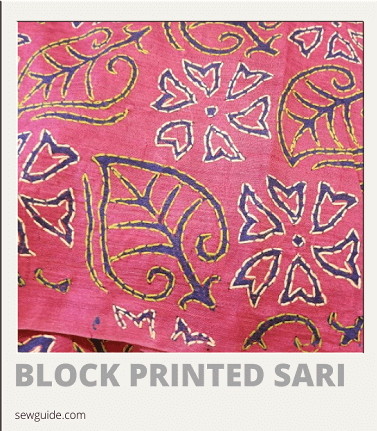
Block printing done on cotton fabrics creates beautiful sari fabrics – ajrakh prints, tye dyes, shibori. sanganeri designs etc are some of the printing done. Carved wooden blocks are used to do the printing and traditionally natural dyes are used.
You can check out this post on Indian patterns for more details.
Bomkai/Sonepuri sari silk & cotton
This is a beautiful sari hand woven in Subarnapur, Orissa State, India with intricate thread work in the Pallu.
Brocade
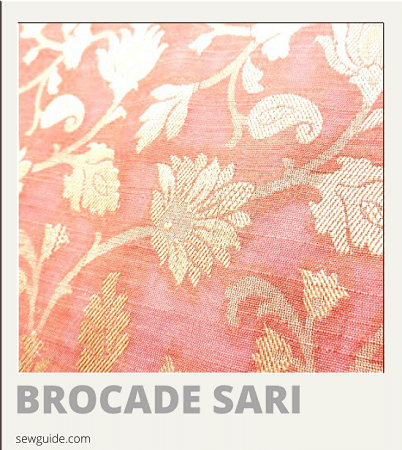
Brocade saris of India were originally made in Banaras for the royal family there. Today it is made of cotton and silk yarns with jacquard weaving and decorated with gold/zari thread.
Chanderi sari
This is a very fine and thin cotton sari made in Madhya Pradesh State in India. There are many fables regarding the thinness and fineness of the fabric with which this sari is made of. These sarees will have small buti designs on the body and very wide borders ( 3 to 3.5 inches) with intricate and beautiful designs. They are usually in light colors or pastel colors.
Chedi Butta sari
This is a sari with the traditional motif woven or printed on it – the motif shows flower and leaf. It is particular to Thirunalveli in Tamilnadu district.
Chettinad Cotton Sari
A cotton sari with dramatic colors and bold check designs, native to Tamil Nadu. It is also known as a kandaangi sari. The distinctive feature of this sari is the vivid contrast colour border with horizontal and vertical stripes.
Chiffon Sari
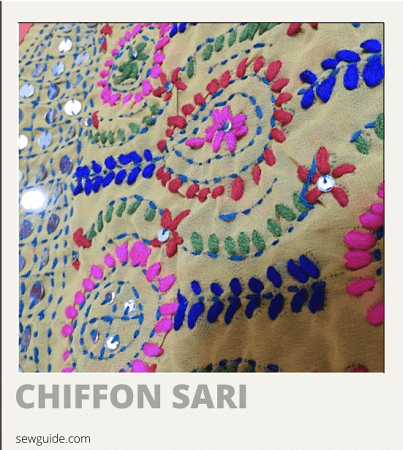
These fine and lightweight saris made of chiffon material usually come in beautiful floral prints. They may also be embroidered. Silk chiffon saris are sheer and lustrous. Chinon Chiffon made of viscose is beautiful and has a great drape and looks just like silk. Marble chiffon saris with a crinkly surface is also called as faux Georgette saris. They are sheer and clingy.
Chikan work sari
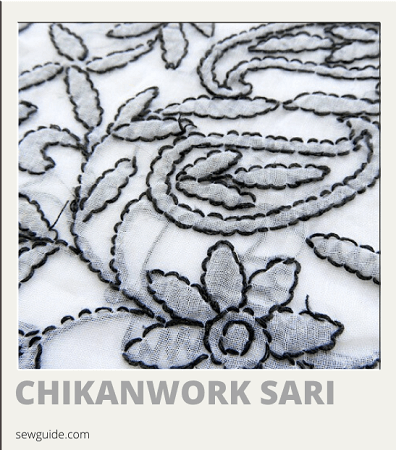
Chikankari work is usually done on muslin saris and Georgette saris. The exquisite work can be done in a simple way or in a very elaborate and ornate way suitable for clothes for wedding.
Chinnalapatti silk cotton saris
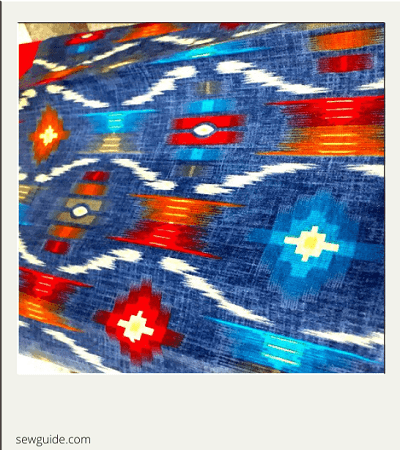
This sari fabric is made as a combination of silk and cotton and woven with tye and dye ikat (pochampilly) designs.
Crepe silk sari
These are pure silk saris with a mat texture – pebbly /crimped texture on the surface. They have a very good graceful drape so they are much in demand. You can get imitation of this sari with polyester fibers – chiffon crepe. But they will not have the luster of the original 100% pure silk crepe saree and will be way thinner and see through.
Dhani Kala sari
This is a white or off white color sari with multi color stripes all over (embroidered or weaved); Originally from West Bengal state in India.
Dharamavaram Silk sari
Dharmavaram sari is a traditional wedding sari in Southern parts of India. These hand loom silk sarees made of Tussar silk (wild silk) come in muted colors and a beautiful double shade in the body of the sari – this is obtained by weaving with yarns of two colors on the warp and weft. The border and the pallu will be in a solid color which is usually contrasting. Brocade motifs in zari thread can be seen scattered along the body. It is made in Andhra Pradesh, India
Dupion silk sari
Dupion Silk sari has distinctive, irregular slubs on the surface with a subtle sheen. It is usually used with an embroidered border.
Eri silk Sari
The silk fabric of this sari is made from silk yarn derived from silk worms fed on castor plant leaves. It is mostly found in Assam state in India. The resultant silk is thick and sometimes coarse and rough with good insulation. (Also called Errandi silk, Ahimsa silk)
Ghar charo sari
This is a red colored wedding silk sari with tiny white dots – sometimes a white silk is scattered with red circular tie and dye motifs – this is also a Ghar charo sari. The sari may also have dancing human figures as motifs.
Ghicha Silk Sari
This is a sari made from hand drawn coarse but strong silk yarn (from pierced, cut, flimsy, insect damaged and double cocoons) called Ghicha. This yarn is blended with pure silk fibers or pure cotton fibers.
Gadwal sari
Gadwal sari is native to Andhra Pradesh state in India. This sari has a cotton body and silk border embellished with zari threads. Full Silk Gadwal saris are also available.
Ikkat Sari
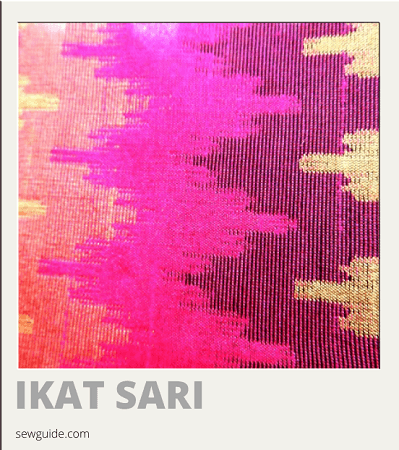
This is a plain Tusser/cotton sari with the pallu and border worked in tie and dye designs – here warp and weft threads were tie-dyed and then woven, creating special patterns that look the same on both sides of the fabric. The border may have a golden weaved strip. Different motifs like flowers, leaves, fish, parrot are made this way. The colors used usually are Olive green, yellow, blue, mauve. Know more on Ikat pattern here
Jaldari Sari
A very fine cotton sari usually in grey color with gold and silver stripes woven into the borders. It is native to West Bengal State in India.
Jamdani Sari
A beautiful sari from Bangladesh (also called dhakaia jamdani) as well as Uttar Pradesh, India. The sari is famous for its weave and lightweight.
Jute sari
Among Jute sarees, Jute silk sarees are the most popular. In Jute silk sari the fabric combines the fibers of Jute and silk.
Kalamkari sari
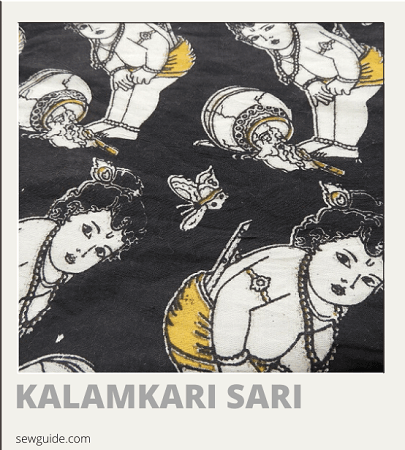
This is a handwoven cotton sari with printed designs – usually very elaborate and intricate designs of Gods and Goddesses and floral designs. Silk Saris with kalamkari designs are also available.
Kanjeevaram Pattu Saris (Kachipuram)
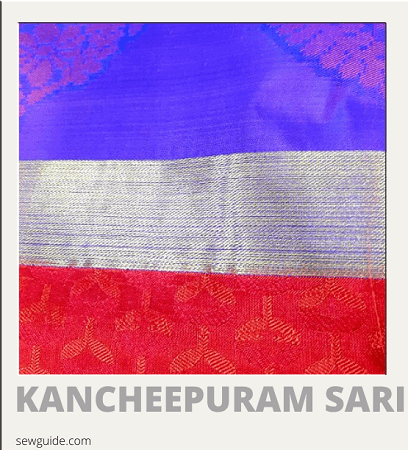
Kanchipuram sari is a lustrous silk sari made in Tamil Nadu state (Kanchipram district). These saris have heavy designs made of zari thread all over the body border and pallu. It is one of the most popular silk saris in India and is used as a wedding sari.
Kanchi cotton saris
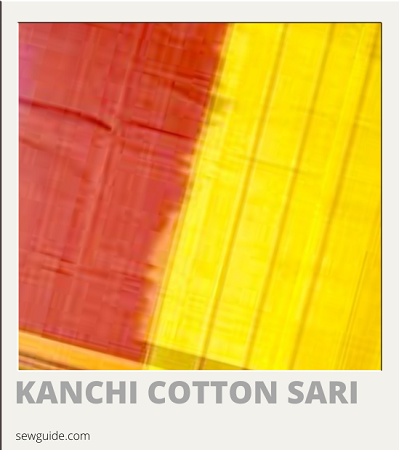
This is a handwoven cotton sari made in the Kancheepuram district of Tamilnadu. They usually have stripe prints and small temple designs along the border.
Kantha embroidered sari
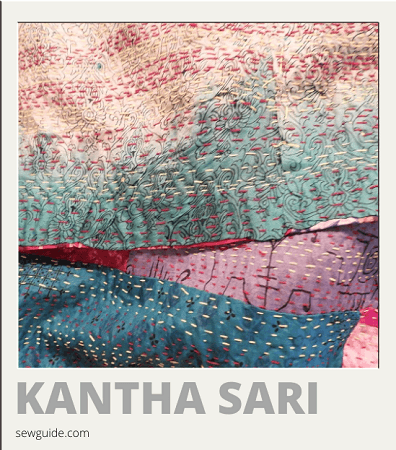
Kantha work is a running stitch embroidery work popular in states of West Bengal and Orissa. Kantha work can be seen on cotton and silk saris.
Kasavu sari
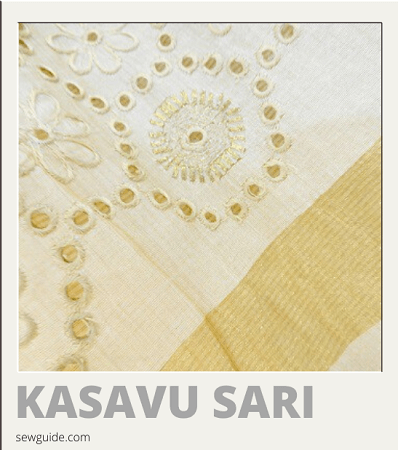
An offwhite sari with golden border from Kerala State, India.
Katan silk
This is one of the softest and most costliest of Banarasi saris.
Khadi silk
Sari fabric in khadi silk is made from handspun silk yarns. Khadi silk is usually 50% cotton and 50% silk. It has a very crisp and neat look and a soft lightweight feel.
Kornad sari (Koorainadu)
This is a cotton or silk Sari with very wide border and pallu. The distinctive feature of this sari is the presence of multicolored check patterns.
Kora Silk Sari
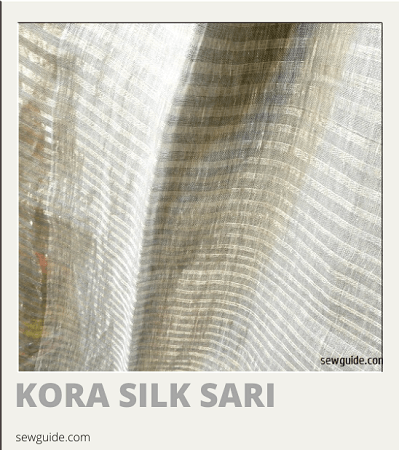
This is an alternative name for Organza silk sari. It is very lightweight and see through.
Kosa silk
This is a silk sari made with the thread made from a particular type of silk worm. It is made in Chattisgarh, India.
Kota Sari
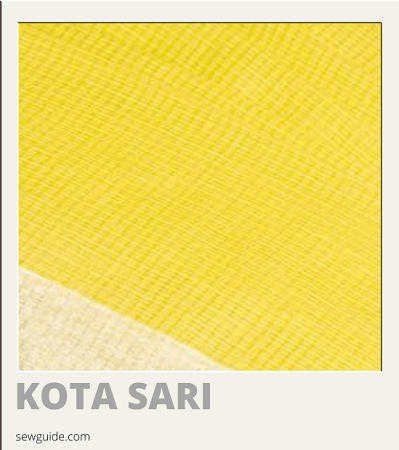
Originally Kota Sari is a fine white, almost see through cotton cloth with self check grid weave patterns all over. It is woven in Kota, Rajasthan and Palaghat and Trivandrum in Kerala.
Kota Doria is a mix of silk and cotton fibers. Kota Doria sari is available as plain with soft checks formed with golden threads, printed with big borders and zari kota with very wide zari borders.
Lal Par Sari
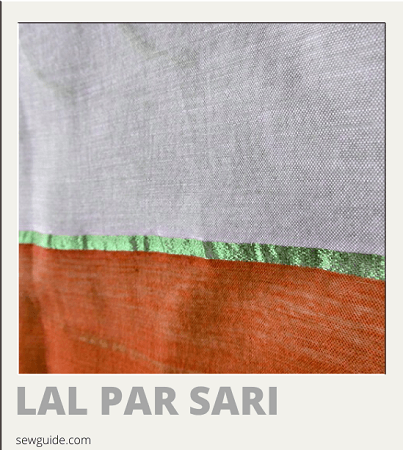
This is a white sari with a red border worn by women in West Bengal state in India.
Linen Sari
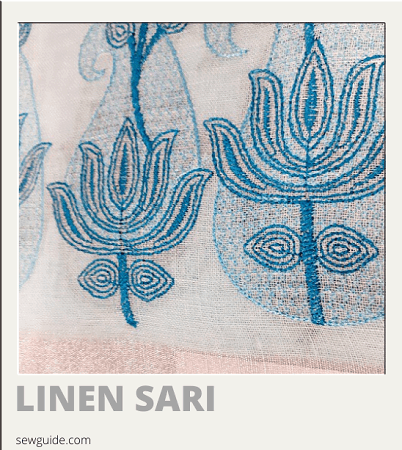
A favourite as a summer wear – this sari has an open weave and is very elegant looking.
Madhubani silk sari
These are cotton or silk saris with Madhubani paintings (mythological paintings depicting scenes from nature, royal life, court scenes etc) on them.
Maheswari sari
The glossy and glamorous Maheshwari sari made in the district of Maheswar in Madhya Pradesh in India, maybe silk, cotton or a combination of cotton and silk fibers. Usually, it is handwoven with cotton thread on the weft and silk on the warp. The most distinctive feature of the Maheswari sari is the presence of a narrow border worked in gold/silver threads and five strips on the pallu (three colored and two white). The border is reversible and the sari can be worn on both sides. The lightweight body of the sari may have self-colored check designs.
Matka Silk Sari
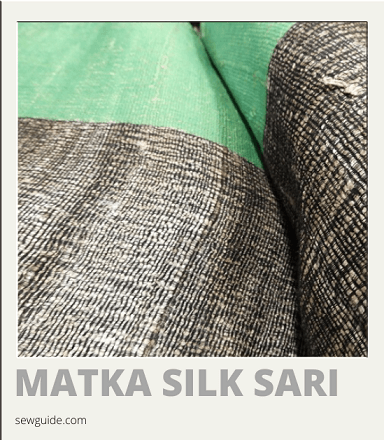
A lightweight but slightly coarse pure silk sari.The rough texture of the sari fabric is its distinctive feature. It is made in West Bengal in India.
Moirang phee sarees
Pure cotton sari with a temple border and a specific woven design called ‘MoirangPheejin’ ; it is made in Manipur state in India.
Mysore Silk
Mysore silk is a pure silk sari with pure gold zari made by Karnataka Silk Industries Corporation, India
Mulmul Cotton Sarees /Muslin saris
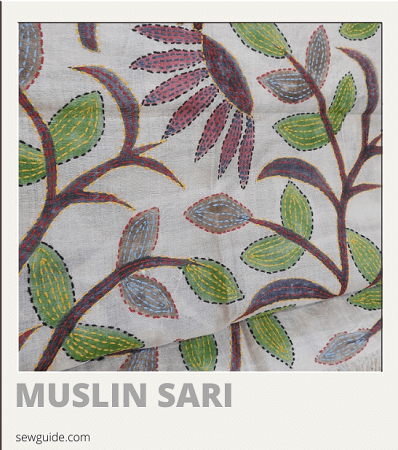
Mulmul is the name of very fine and loosely woven cotton fabric. It is a lightweight and airy fabric suited for the hot weather in the subcontinent. Embroidery and trims may be added to mulmul saris to change its ordinary looks. Dhakai Muslin Sari is a super fine muslin sari from Bangladesh.
Muga silk sari
Gold colored Silk sari from Assam, India.
Mundum Neriyathum
This is the traditional clothing of women in Kerala, a state in Southern India and is said to be a precursor of the modern day sari. It is off-white in colour with a contrast thin border (black/red/gold etc). It consists of two pieces – one piece used as a skirt and the other part used as a pallu to cover the top part of the body.
Narayani Patt Saris
Pure silk saris with border and pallu in contrasting colors from the body of the sari.
Narayanpet saris
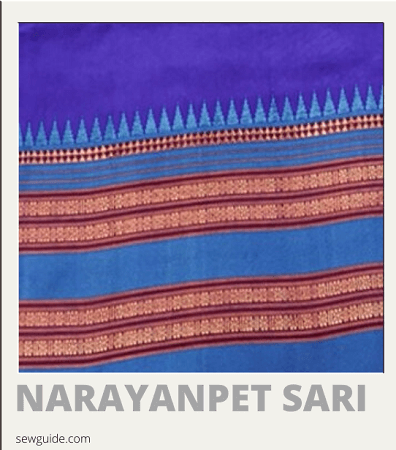
These are cotton saris made in Andhra Pradesh state – they have solid colored body and a contrasting colored borders – they also will have stripes of zari work along the borders.
Net Saris
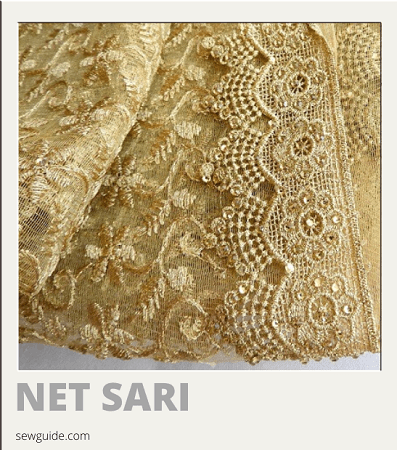
Net fabric when used to make saris are usually embroidered or decorated with trims or borders.
Pasapalli
Pasapalli sari is a hand woven sari made of silk fabric
Party wear saris
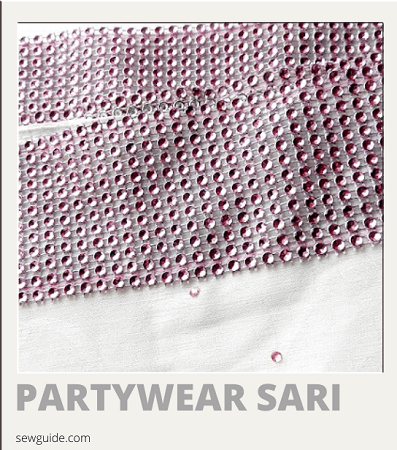
This is the general name given to all kinds of saris embellished with decorative elements like Resham work, gota pattis, zardozi work, sequins, zari, print and even embroidery like Kantha work suitable for attending occasions like weddings, party etc. These saris are usually in satin, velvet, brocade, Georgette or chiffon fabrics.
Pat silk
White colored silk sari from Assam, India.
Patola Sari
These are tie and dye saris made in very bright colors like red, yellow, turquoise, black, green, deep mauve. They are originally made in Gujarat state, India. The body of the sari has geometrical patterns as well as motifs of diamond shapes, birds like the swan and other flying birds and animals like elephants and dancing human forms, three flowers on a stem on the border.
Paithan saris (Paithani)
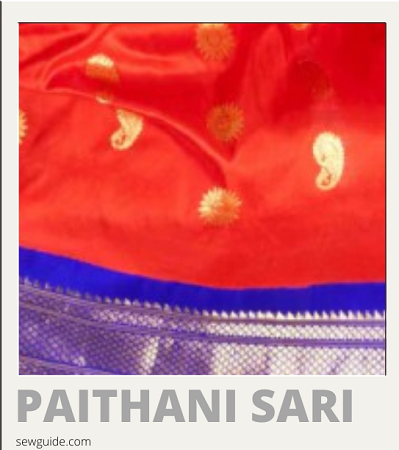
This is a fine thin silk sari with brocade work with golden pallu and border. It will have a silver or golden border and small motifs all over the body. The sari is named after a place called Paithan in Maharashtra state in India. For weddings, a red silk sari is used. The body of the sari and border are made separately and then joined unlike any other saris. Also called Pitambar saris.
Pochampilli sari
This is a tie and dye sari made in Andhra Pradesh, India with geometrical patterns. Colors used in pochampilli dyeing are white, black, brown, green and purple.
Polycotton sari
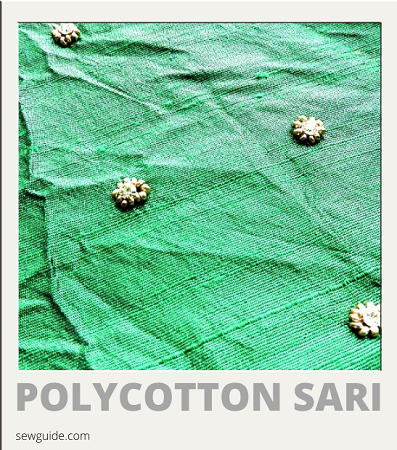
Polycotton fabric combines the goodness of cotton and polyester and has a silk like sheen – with even the slubs imitated as in wild silk. It is usually used as an inexpensive option as a base for embroidery worked saris.
Resham worked Sari
Resham work is embroidery done with colored silk thread.
Salem Silk Sari
A beautifully lustrous and fine silk sari with beautiful zari border with designs, made in Salem district in Tamil Nadu state. Salem Venpattu silk is a pure white silk sari. The satin like finish of Salem silk is very famous.
Sambalpuri Sari
An ikat woven sari made in Sambalpur, Orissa.
Sungudi Sari (Sungudi Seelai)
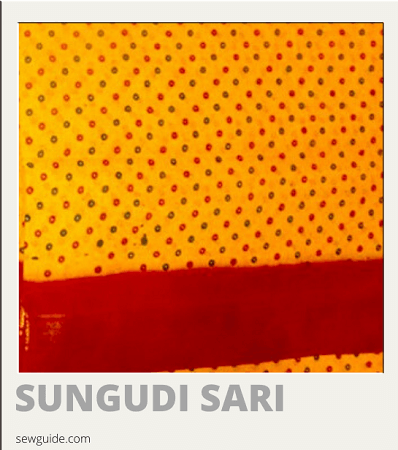
This is a tie and dye Cotton sari made in Tami Nadu state, India (Chinnalapatti, Tamil Nadu). The sari has tiny golden patterns all over the body and a golden stripe between the body and the border and the pallu. The usual colors are bright colors of dark green, yellow, magenta, yellow, red.
Tabby silk Sari
A beautiful printed lightweight and lustrous silk fabric in a Tabby weave.
Tant Sari
Fine cotton sari handwoven with wide borders and decorative pallu with floral and other natural designs. Native to West Bengal, India and Bangladesh. It is a relatively inexpensive sari.
Thirubhuvanam sari
A very popular silk sari with a GI tag in India. It is handwoven with pure silk and pure zari thread and it takes about 15 days for the whole sari to be made. The sari has a one side wide border which has elaborate zari work on intricate traditional motifs.
Tircha Baluchar
Fine cotton saris with diagonal patterns made in West Bengal, India.
Tangail sari
A cotton Sari from Shantipur, West Bengal State in India with embroidered thread weaved into it as small motifs all over the body of the sari.
Temple saree
Heavy silk Saris with a lot of zari work done all over with temple designs. Cotton Temple saris are also available.
Tanjaore sari
This is a sheer and bright colored sari with a zari border.
Tassar silk (Tusser)
Pure Silk saris with a rough texture made from silk fibers from wild silk worms.
Tissue sari
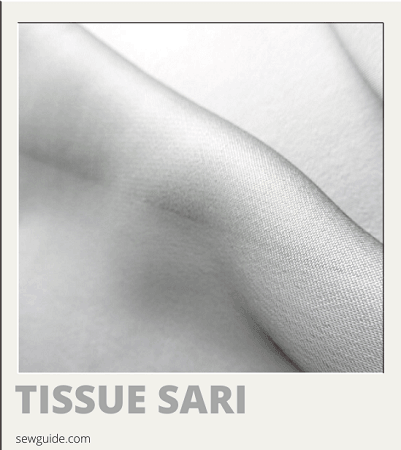
This is sari made with a thin organza/gauze like lustrous fabric woven with silk or other synthetic fibers. Kota tissue sari is a beautiful variety of this kind. It is almost sheer with a beautiful shine and very lightweight. It has a crisp hand and stays in place when pleated.
Uppada pattu sari
This is a handwoven fine silk sari made using the jamdani weaving method with pure zari thread woven into it. The distinctive feature of the uppada silk is the lightweight and soft feel of the fabric.
Venkatagiri Sari
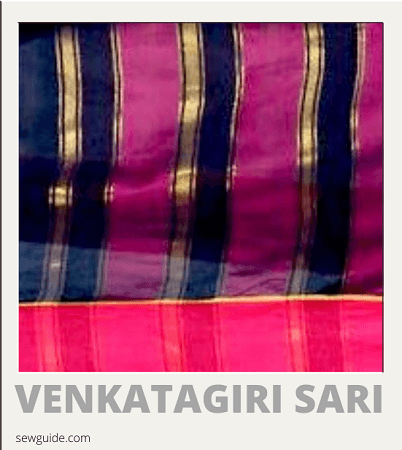
Venkatagiri Saris are made in the Indian state of Andhra Pradesh. These are made in cotton fabric in solid colors with unique zari designs in on the border. Small Floral motifs and bird motifs in zari thread may be scattered over the body of the sari. The borders will be in a contrasting color from the body of the sari.
Zari worked sari
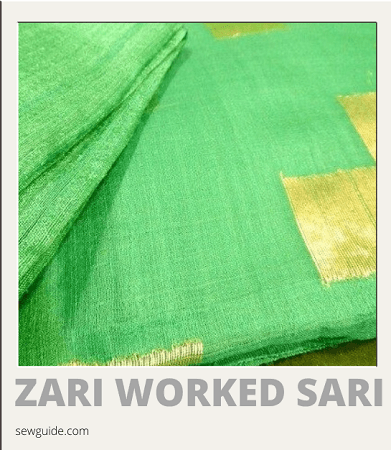
Raised patterns woven with gold or silver thread- this is called zari work. Most of the wedding silk saris are zari worked sarees. Zari is a golden coloured thread containing 65% of silver and 0.65% of gold. Today most of the zari used in inexpensive saris are imitation zari thread made of coated nylon filament thread which loses color after some washes.
Zardozi worked sari
Zardozi embroidery is used as embellishment on saris. Special zardosi Metallic threads in gold, bronze and silver colors are used to do the zardosi work and Swarovski crystals, pearls etc are used along with the work.
Related posts : Sari wash and care ; Sew a sari blouse; Sew sari petticoat; Indian fabric prints and patterns ; 50+ different types of silk fabrics. ; Indian traditional clothing for men
Reference : https://www.utsavpedia.com/textiles/.
